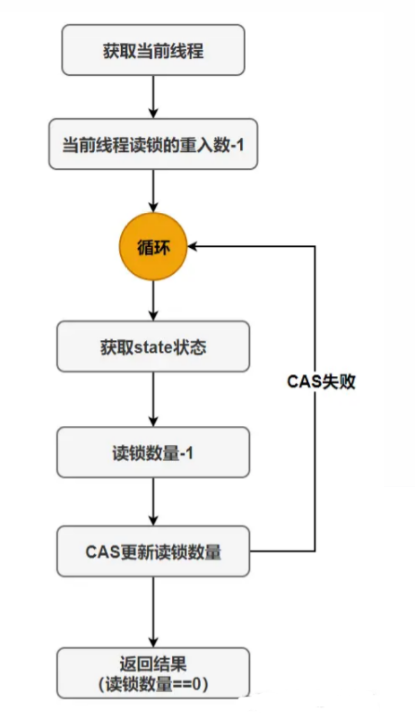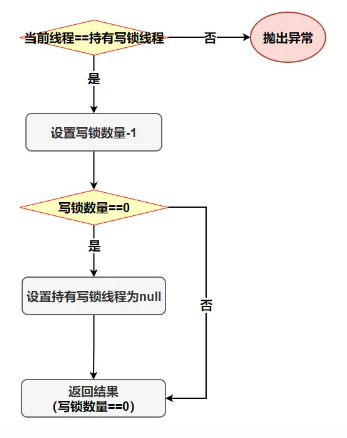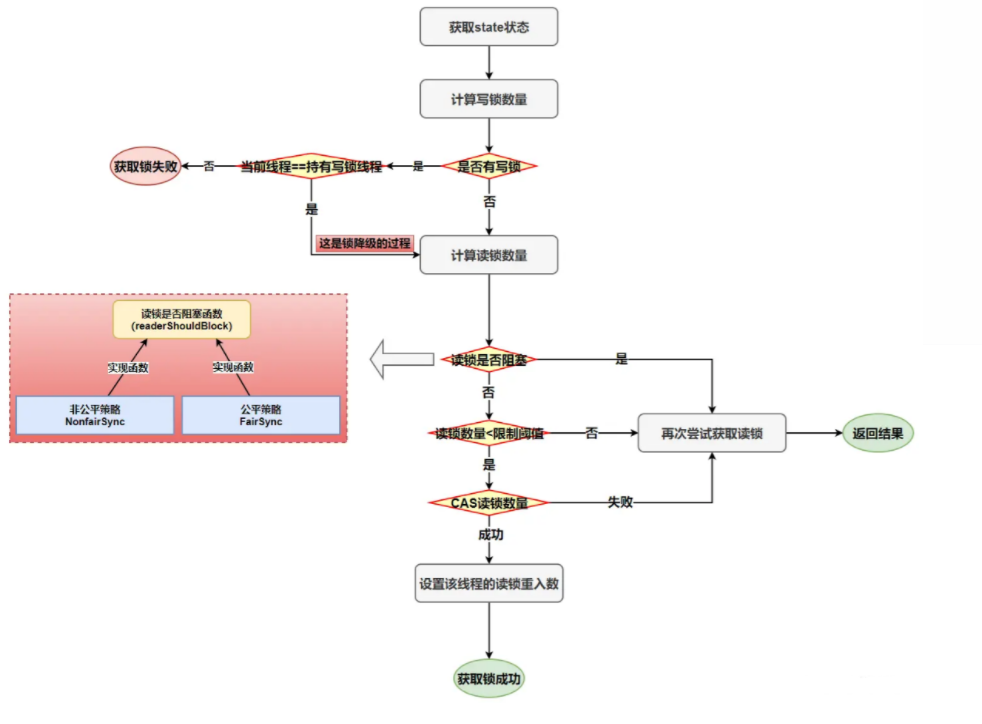读写锁介绍
场景:读多写少,
读读共享
读写,写写,写读 互斥
为了提高并发量,吞吐量
ReentrantReadWriteLock:维护了一对相关的锁,一个只读操作,一个写入操作
线程进入读锁的前提条件:
- 没有其他线程的写锁
-
线程进入写锁的前提条件:
没有其他线程的读锁
-
读写锁有以下三个重要的特性
公平选择性:支持非公平(默认)和公平的锁获取方式,吞吐量还是非公平优于公平。
- 可重入:读锁和写锁都支持线程重入。以读写线程为例:读线程获取读锁后,能够再次获取读锁。写线程在获取写锁之后能够再次获取写锁,同时也可以获取读锁。
- 锁降级:遵循获取写锁、再获取读锁最后释放写锁的次序,写锁能够降级成为读锁。
ReentrantReadWriteLock的使用
ReadWriteLock:
public interface ReadWriteLock {/** Returns the lock used for reading.* @return the lock used for reading*/Lock readLock();/** Returns the lock used for writing.* @return the lock used for writing*/Lock writeLock();}
ReentrantReadWriteLock: 可重入的读写锁实现类
写锁:独占
读锁:共享
public class ReentrantReadWriteLockimplements ReadWriteLock, java.io.Serializable {private static final long serialVersionUID = -6992448646407690164L;/** Inner class providing readlock */private final ReentrantReadWriteLock.ReadLock readerLock;/** Inner class providing writelock */private final ReentrantReadWriteLock.WriteLock writerLock;/** Performs all synchronization mechanics */final Sync sync;
如何使用读写锁
private ReadWriteLock readWriteLock = new ReentrantReadWriteLock();private Lock r = readWriteLock.readLock();private Lock w = readWriteLock.writeLock();// 读操作上读锁public Data get(String key) {r.lock();try {// TODO 业务逻辑}finally {r.unlock();}}// 写操作上写锁public Data put(String key, Data value) {w.lock();try {// TODO 业务逻辑}finally {w.unlock();}}
注意事项
- 读锁不支持条件变量
- 重入时升级不支持:持有读锁的情况下去获取写锁,会导致获取永久等待
- 重入时支持降级: 持有写锁的情况下可以去获取读锁
示例Demo
public class Cache {static Map<String, Object> map = new HashMap<String, Object>();static ReentrantReadWriteLock rwl = new ReentrantReadWriteLock();static Lock r = rwl.readLock();static Lock w = rwl.writeLock();// 获取一个key对应的valuepublic static final Object get(String key) {r.lock();try {return map.get(key);} finally {r.unlock();}}// 设置key对应的value,并返回旧的valuepublic static final Object put(String key, Object value) {w.lock();try {return map.put(key, value);} finally {w.unlock();}}// 清空所有的内容public static final void clear() {w.lock();try {map.clear();} finally {w.unlock();}}
锁降级
写锁 ——> 读锁
先把持写锁——>再获取读锁——-> 再释放写锁-
目的:保证线程修改的数据能够被其他线程可见,主要是为了保证数据的可见性
如果当前线程不获取读锁而是直接释放写锁,假设此刻另一个线程(记作线程T)获取了写锁并修改了数据,那么当前线程无法感知线程T的数据更新。如果当前线程获取读锁,即遵循锁降级的步骤,则线程T将会被阻塞,直到当前线程使用数据并释放读锁之后,线程T才能获取写锁进行数据更新
不支持锁升级
目的也是保证数据可见性,如果读锁已被多个线程获取,其中任意线程成功获取了写锁并更新了数据,则其更新对其他获取到读锁的线程是不可见的。
private final ReentrantReadWriteLock rwl = new ReentrantReadWriteLock();private final Lock r = rwl.readLock();private final Lock w = rwl.writeLock();private volatile boolean update = false;public void processData() {readLock.lock();if (!update) {// 必须先释放读锁readLock.unlock();// 锁降级从写锁获取到开始writeLock.lock();try {if (!update) {// TODO 准备数据的流程(略)update = true;}readLock.lock();} finally {writeLock.unlock();}// 锁降级完成,写锁降级为读锁}try {//TODO 使用数据的流程(略)} finally {readLock.unlock();}}
ReentrantReadWriteLock源码分析
类结构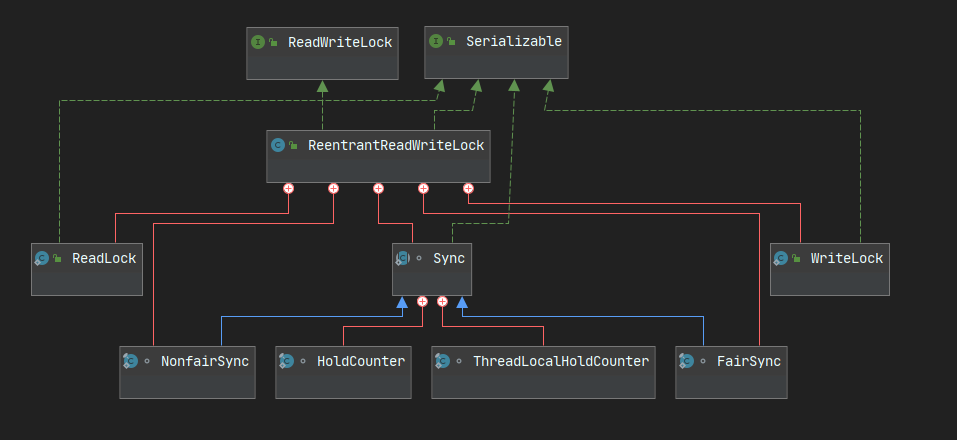
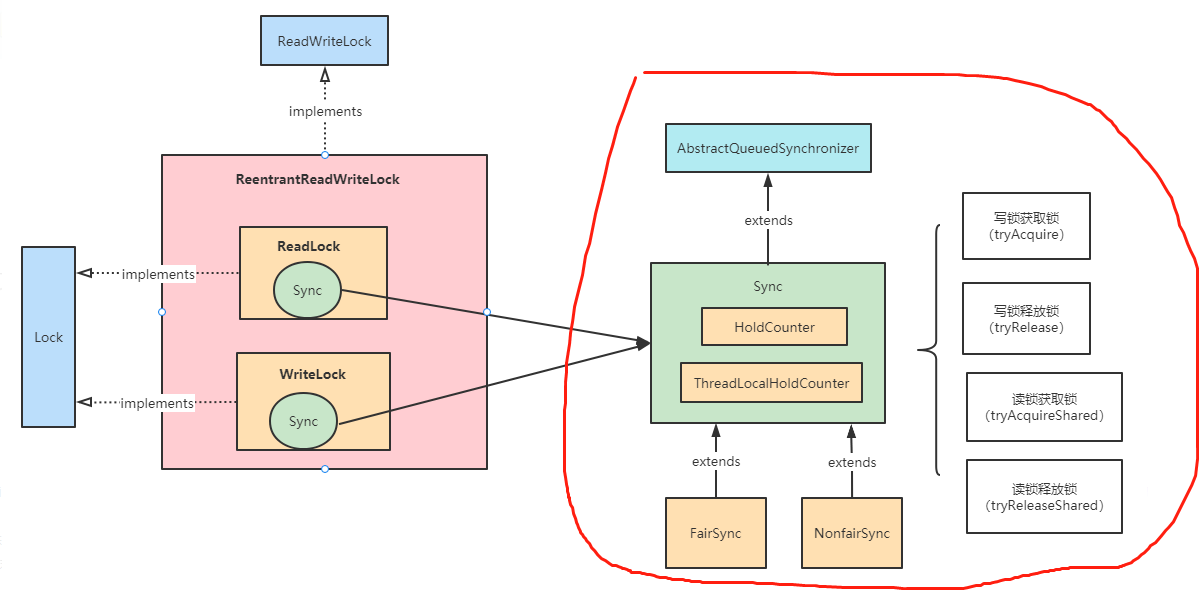
读写锁的设计
使用Sync 的int 类型 state 表示同步状态
把一个变量,分为两步分: 高16位表示读,低16位表示写
假如当前同步状态为S,那么:
- 写状态:等于 S & 0x0000FFFF 把高位16位 全部抹去,当写状态加1 ,等于 S + 1
- 读状态:等于 S >>> 16 , 0 右移16位,当读状态加1,等于 s + (1<<16)也就是 S + 0x00010000
推论:S 不等于0时,当写状态(S&0x0000FFFF) 等于0 ,则读状态 (S >>>16) 大于0 ,读锁已经获取
static final int SHARED_SHIFT = 16;static final int SHARED_UNIT = (1 << SHARED_SHIFT);static final int MAX_COUNT = (1 << SHARED_SHIFT) - 1;static final int EXCLUSIVE_MASK = (1 << SHARED_SHIFT) - 1;/** Returns the number of shared holds represented in count* 获取持有读状态锁的线程数量,读锁可以被多个线程持有,读锁支持重入特性,每个线程持有的读锁的数量是单独计算的,HoldCounter 计算器*/static int sharedCount(int c) { return c >>> SHARED_SHIFT; }/** Returns the number of exclusive holds represented in count* 获得持有写状态的锁的次数*/static int exclusiveCount(int c) { return c & EXCLUSIVE_MASK; }
HoldCounter 计数器
读锁的内在机制其实就是一个共享锁。一次共享锁的操作就相当于对HoldCounter 计数器的操作。获取共享锁,则该计数器 + 1,释放共享锁,该计数器 - 1。只有当线程获取共享锁后才能对共享锁进行释放、重入操作。
/*** A counter for per-thread read hold counts.* Maintained as a ThreadLocal; cached in cachedHoldCounter*/static final class HoldCounter {int count = 0;// Use id, not reference, to avoid garbage retentionfinal long tid = getThreadId(Thread.currentThread());}/***HoldCounter与线程绑定,记录当前线程的重入次数的*/static final class ThreadLocalHoldCounterextends ThreadLocal<HoldCounter> {public HoldCounter initialValue() {return new HoldCounter();}}
- HoldCounter是用来记录读锁重入数的对象
- ThreadLocalHoldCounter是ThreadLocal变量,用来存放不是第一个获取读锁的线程的其他线程的读锁重入数对象
写锁的获取
写锁是一个支持重进入的排它锁
如果是当前线程获取的写锁,则增加写状态
如果当前线程获取血锁时,读锁已经被获取,或该线程不是获取写锁的线程,则等待
protected final boolean tryAcquire(int acquires) {//当前线程Thread current = Thread.currentThread();//获取state状态 存在读锁或者写锁,状态就不为0int c = getState();//获取写锁的重入数int w = exclusiveCount(c);//当前同步状态state != 0,说明已经有其他线程获取了读锁或写锁if (c != 0) {// c!=0 && w==0 表示存在读锁// 当前存在读锁或者写锁已经被其他写线程获取,则写锁获取失败if (w == 0 || current != getExclusiveOwnerThread())return false;// 超出最大范围 65535if (w + exclusiveCount(acquires) > MAX_COUNT)throw new Error("Maximum lock count exceeded");//同步state状态setState(c + acquires);return true;}// writerShouldBlock有公平与非公平的实现AQS实现的, 非公平返回false,会尝试通过cas加锁//c==0 写锁未被任何线程获取,当前线程是否阻塞或者cas尝试获取锁if (writerShouldBlock() ||!compareAndSetState(c, c + acquires))return false;//实现重入的功能//设置写锁为当前线程所有setExclusiveOwnerThread(current);return true;}

- 读写互斥
- 写写互斥
- 写锁支持同一个线程重入
writerShouldBlock写锁是否阻塞实现取决公平与非公平的策略(FairSync和NonfairSync)
写锁的释放
写锁释放通过重写AQS的tryRelease方法实现
protected final boolean tryRelease(int releases) {//若锁的持有者不是当前线程,抛出异常if (!isHeldExclusively())throw new IllegalMonitorStateException();int nextc = getState() - releases;//当前写状态是否为0,为0则释放写锁boolean free = exclusiveCount(nextc) == 0;if (free)setExclusiveOwnerThread(null);//把独占线程设置为空setState(nextc);return free;}
读锁的获取
实现共享式同步组件的同步语义需要通过重写AQS的tryAcquireShared方法和tryReleaseShared方法。读锁的获取实现方法为:
protected final int tryAcquireShared(int unused) {Thread current = Thread.currentThread();int c = getState();// 如果写锁已经被获取并且获取写锁的线程不是当前线程,当前线程获取读锁失败返回-1// 判断锁降级if (exclusiveCount(c) != 0 &&getExclusiveOwnerThread() != current)return -1;//计算出读锁的数量int r = sharedCount(c);/*** 读锁是否阻塞 readerShouldBlock()公平与非公平的实现* r < MAX_COUNT: 持有读锁的线程小于最大数(65535)* compareAndSetState(c, c + SHARED_UNIT) cas设置获取读锁线程的数量*/if (!readerShouldBlock() &&r < MAX_COUNT &&compareAndSetState(c, c + SHARED_UNIT)) { //当前线程获取读锁if (r == 0) { //设置第一个获取读锁的线程firstReader = current;firstReaderHoldCount = 1; //设置第一个获取读锁线程的重入数} else if (firstReader == current) { // 表示第一个获取读锁的线程重入firstReaderHoldCount++;} else { // 非第一个获取读锁的线程HoldCounter rh = cachedHoldCounter;if (rh == null || rh.tid != getThreadId(current))cachedHoldCounter = rh = readHolds.get();else if (rh.count == 0)readHolds.set(rh);rh.count++; //记录其他获取读锁的线程的重入次数}return 1;}// 尝试通过自旋的方式获取读锁,实现了重入逻辑return fullTryAcquireShared(current);}
读锁共享,读读不互斥
- 读锁可重入,每个获取读锁的线程都会记录对应的重入数
- 读写互斥,锁降级场景除外
- 支持锁降级,持有写锁的线程,可以获取读锁,但是后续要记得把读锁和写锁读释放
- readerShouldBlock读锁是否阻塞实现取决公平与非公平的策略(FairSync和NonfairSync)
读锁的释放
获取到读锁,执行完临界区后,要记得释放读锁(如果重入多次要释放对应的次数),不然会阻塞其他线程的写操作。
读锁释放的实现主要通过方法tryReleaseShared:
protected final boolean tryReleaseShared(int unused) {Thread current = Thread.currentThread();//如果当前线程是第一个获取读锁的线程if (firstReader == current) {// assert firstReaderHoldCount > 0;if (firstReaderHoldCount == 1)firstReader = null;elsefirstReaderHoldCount--; //重入次数减1} else { //不是第一个获取读锁的线程HoldCounter rh = cachedHoldCounter;if (rh == null || rh.tid != getThreadId(current))rh = readHolds.get();int count = rh.count;if (count <= 1) {readHolds.remove();if (count <= 0)throw unmatchedUnlockException();}--rh.count; //重入次数减1}for (;;) { //cas更新同步状态int c = getState();int nextc = c - SHARED_UNIT;if (compareAndSetState(c, nextc))// Releasing the read lock has no effect on readers,// but it may allow waiting writers to proceed if// both read and write locks are now free.return nextc == 0;}}
